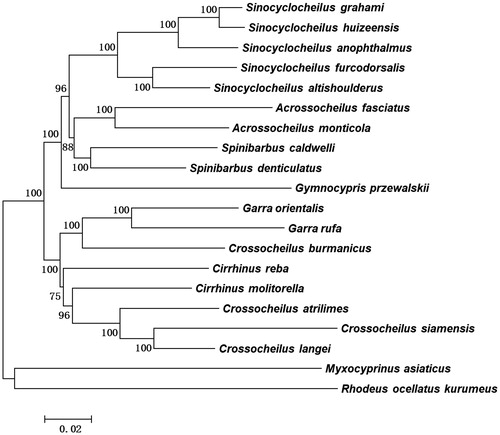Abstract
In this study, the complete mitochondrial genome of Sinocyclocheilus huizeensis has been determined by polymerase chain reaction method for the first time. The overall base composition of Sinocyclocheilus huizeensis mitogenome is 30.8% for A, 27.0% for C, 16.9% for G and 25.3% for T. The percentage of G + C content is 43.9%. The mitogenome is a circular DNA molecule of 16,585 bp in length with a D-loop region and contains 22 transfer RNA (tRNA) genes, two ribosomal RNA (rRNA) genes and 13 protein-coding genes. The mitochondrial genome sequencing for Sinocyclocheilus huizeensis in this study provides important molecular data for further evolutionary analysis for Cyprinoidea.
Sinocyclocheilus huizeensis, which belongs to order Cyprinoidea, family Cyprinidae, genus Sinocyclocheilus, is a new cyprinid species which was discovered from a spring at Niulanjiang River in Huize County, Yunnan, China (Cheng et al. Citation2015). This species is endemic to the Karst area of the Yunnan-Guizhou Plateau.
Sinocyclocheilus huizeensis samples of this study were collected from Huize county of Yunnan Province in China (26°44′N; 103°28′E). The specimen is stored in Heilongjiang River Fisheries Research Institute and its accession number is hrfri2018046. The genome DNA was extracted following the traditional phenol-chloroform method (Taggart et al. Citation1992). Twenty-six primers were designed to amplify the PCR products for sequencing. The sequencing results were then assembled using ContigExpress 9.0 software (New York, NY). The transfer RNA (tRNA) genes were identified using the program tRNAscan-SE 1.21 (http://lowelab.ucsc.edu/tRNAscan-SE). The locations of protein-coding genes were determined by comparing with the corresponding known sequences of other Sinocyclocheilus fish species.
The complete mitochondrial genome length of Sinocyclocheilus huizeensis was 16,585 bp in length (GenBank accession number MH982229). It consisted of 13 protein-coding genes, two rRNA genes, 22 tRNA genes and one D-loop region. The overall base composition of the mitogenome is 30.8% for A, 27.0% for C, 16.9% for G and 25.3% for T. The percentage of G + C content is 43.9%. To validate the phylogenetic position of Sinocyclocheilus huizeensis, we perform multiple sequence alignment and MEGA 6.0 (Tamura et al. Citation2013) to construct a neighbour-joining tree containing complete mitochondrial genome DNA of 20 species in Cyprinoidea. As shown in the phylogenetic tree (), our sequence was clustered in genus Sinocyclocheilus, including Sinocyclocheilus anophthalmus, Sinocyclocheilus grahami, Sinocyclocheilus furcodorsalis and Sinocyclocheilus altishoulderus.
Figure 1. A neighbour-joining (NJ) tree of the 20 species from Cyprinoidea was constructed based on complete mitochondrial genome data. The analyzed species and corresponding NCBI accession numbers are as follows: Sinocyclocheilus graham (GQ148557.1), Sinocyclocheilus huizeensis (MH982229), Sinocyclocheilus anophthalmus (NC_023472.1), Sinocyclocheilus furcodorsalis (GU589570.1), Sinocyclocheilus altishoulderus (FJ984568.1), Acrossocheilus fasciatus (KF781289.1), Acrossocheilus monticola (NC_022145.1), Spinibarbus caldwelli (NC_022149.1), Spinibarbus denticulatus (AP013335.1), Gymnocypris przewalskii (NC_019604.1), Garra orientalis (AP011202.1), Garra rufa (NC_022941.1), Cirrhinus reba (NC_029445.1), Cirrhinus molitorella (AP011390.1), Crossocheilus burmanicus (NC_029446.1), Crossocheilus langei (NC_029443.1), Crossocheilus siamensis (NC_031827.1), Crossocheilus atrilimes (NC_029447.1), Myxocyprinus asiaticus (AY526869.1), and Rhodeus ocellatus kurumeus (AB070205.1).

Disclosure statement
The authors report no conflicts of interest. The authors alone are responsible for the content and writing of the paper.
Additional information
Funding
References
- Cheng C, Pan X, Chen X, Li J, Ma L, Yang J. 2015. A new species of the genus Sinocyclocheilus (Teleostei: Cypriniformes), from Jinshajiang Drainage, Yunnan, China. Cave Res. 2:4.
- Taggart JB, Hynes RA, Prodouhl PA, Ferguson A. 1992. A simplified protocol for routine total DNA isolation from salmonid fishes. J Fish Biol. 40:963–965.
- Tamura K, Stecher G, Peterson D, Filipski A, Kumar S. 2013. MEGA6: molecular evolutionary genetics analysis version 6.0. Mol Biol Evol. 30:2725–2729.
